Unconscious influence
Editor's note: Jack Shimell is president of Inner Response, Inc., a Charlotte, N.C., research company.
For over 70 years, advertisers and their agencies have been attempting to evaluate the effectiveness of advertising. During the 1920s this was mostly done in a simple and straightforward manner. Print was the dominant medium. Most ads at that time contained open or hidden calls to action (e.g., asking consumers to send in a coupon). Effectiveness was measured by simply counting the numbers. Legendary copywriter Claude Hopkins may not have invented this technique but he used it extensively.
In the late 1920s and through the 1930s radio advertising became significant. As a consequence somewhat more indirect forms of measurement began to emerge - phone surveys to measure listeners and ad awareness, mostly by various recall measures. By the late '40s and particularly the early '50s, television began its climb, with concurrent interest in measuring both audience and ad effectiveness. On-air recall became the dominant means of doing this. The recall score began to be the brand manger's mantra. "Did it beat the norm?" was the common question. It wasn't long, however, before agency creatives began to complain about recall not measuring what they were trying to do. Weak, if any, correlations with sales results supported their complaints.
Coincident with this was the rise of motivation research, pioneered by Ernest Dichter, who in 1960 said: "Human motivations are frequently unconscious and represent intertwined and complicated mechanisms. Modern psychiatry and all other social sciences could not exist without the acceptance of this fact." 1
Many agency creatives and others latched onto this in the hope of getting rid of recall, but to no avail. It had become too entrenched; and the retort "If people can't remember it, it can't be any good" was hard to refute. Dichter was often criticized for shoddy research design, as others were unable to replicate his findings. They missed the point. His techniques were not his strong suit; his intuitive insights were often brilliant, but so were his misses.
Further, developing a technique to measure unconscious cognition proved elusive, although Horace Schwerin and others who followed were gradually able to demonstrate that indirect measures of unconscious influence such as pre/post and post-only attitude measures did often evidence correlations with sales results and/or reported brand usage.
In relative terms, these attitude change measures were significantly better than on-air or off-air recall measures. But old habits die hard and conscious recall and copy playback measures are still commonplace today, despite their history as poor predictors of marketplace performance.
Measuring unconscious influences
As early as the 1950s, a small but significant number of researchers attempted to introduce physiological measures as a means of overcoming the limitations of direct questioning. Principal among these was galvanic skin (resistance) response (GSR), the primary component, then and now, in lie detection equipment. The equipment was crude, results could not readily be integrated with a subject's questionnaire response and practitioners too often relied on the stress component, phasic response, as opposed to the underlying tonic or attention component. The biggest hurdle though proved to be establishing that unconscious cognition was both a precursor and a continuous parallel to conscious cognition. Behaviorist psychologists, led by B.F. Skinner, dismissed unconscious influences as being trivial at best. Neurologists and most brain researchers at the time agreed.
In the 1970s non-verbal techniques such as dials and button measurement devices became popular in an attempt to get past the limitations of language. They appeared to be as reliable as direct questioning in measuring attitude changes and also proved useful as a diagnostic device in measuring likability and other attitude attributes. Since response was consciously controlled, they could not get into the realm of unconscious affect, despite some claims to do so.
"Discovery" of unconscious attention
In 1983, the famous medical researcher Jonas Salk said: "We all have many more sensitivities than we know. More things affect us without our conscious awareness or concern and make a difference to us than we know." 2
According to a February 1996 American Psychologist article:
"Unlike explicit memory, which depends critically on paying adequate attention to the information to be learned, implicit memory can be robust even without full attention." 3
Thanks to advances in medical examination technology such as MRI, PET and CAT scan techniques, neuropsychologists and other brain researchers have been able to establish that cognition is a dual function, with both conscious and unconscious attention occurring simultaneously. Several researchers have also established that unconscious attention/awareness almost always occurs in fractions of a second before any conscious awareness begins.
T-scope experiments are the easiest to perform. A slide is exposed in hundredths of a second, which falls below conscious perception, yet cognition generally occurs, but at an unconscious level and is only determined by indirect questioning.
Evelyn Wood, the speed-reading firm, used subliminal techniques to persuade students that they can read at very high speed, often in excess of 1,000 words per minute. One cannot silently mouth the words at these speeds, yet comprehension is often greater than when read at much slower speeds. To read at high speed, greater concentration is required. The unconscious mind at this point is doing almost all the work. In comprehension reviews students often score better after reading at high speed than at slower speeds.
(The author took the Evelyn Wood speed reading course years ago and recalls that one of the slides shown at high speed seemed to say: "The dog chased the cat." Everyone in the class agreed that that's what it said, but when the slide was shown again we discovered it really said, "Chased the cat the dog." Our unconscious minds had simply unscrambled the words and put them in the right order.)
Measuring emotion and unconscious processing
In 1996 in The Emotional Brain Joseph LeDoux said: "Emotions are notoriously difficult to verbalize. They operate in some psychic and neural space that is not readily accessed from consciousness...Yet, much of our understanding of the way the emotional mind works has been based on studies that have used verbal stimuli as the gateway to emotions or verbal reports to measure emotions. We will not likely begin to fully understand the workings of human unconscious processes until we turn away from the use of verbal stimuli and verbal reports." 4
Psychiatrist and brain researcher Rhawn Joseph said in his 1992 book The Right Brain and the Unconscious:
"When one is listening to music, the left brain attends to rhythm (i.e., temporal sequences) and the words, and the right brain to the melody and the emotion conveyed. Similarly when one is talking to a friend, a loved one...the right brain attends to the way things are being said and the left brain attends only to what is being said. Two different messages may be perceived."
"Interestingly, whereas the left frontal lobe maintains inhibitory control over the left brain, the right frontal lobe exerts inhibitory influences on what is processed in either half of the brain. Indeed, the entire right brain appears to be dominant in regard to attention and arousal." 5
Note: Not all brain researchers believe the rational/emotional, conscious/unconscious are so cleanly delineated by left brain/right brain descriptions Joseph employs; nonetheless, many find it a convenient way to figuratively, if not literally, describe the differences.
Recognition of the need for a measurement beyond recording conscious responses is not new. A few researchers were experimenting back in the 1950s and 1960s. Some employed galvanic skin response, others pupil dilation, eye movement, voice stress, and brain waves. Pupil dilation and voice stress have, to our knowledge, never been found useful for evaluating time-based or broadcast material.
Sophisticated eye movement measurement equipment has carved out a niche as a useful tool in evaluating print, billboard, and other static material. One example is a study 6 conducted at The University of Georgia which evaluated the efficacy of cigarette warnings in print ads and on cigarette packages with eye movement cameras for the National Cancer Society.
Brainwave measurements have started to come into their own. Recently Rossiter and several peers offered evidence as to how brainwave analysis can isolate and evaluate key themes in a commercial 7. Many more researchers have been experimenting with brainwaves with, no doubt, more reports to follow.
Much has been and continues to be learned by studying brain patterns to see how the brain functions. However, in evaluating external stimuli, such as television commercials, brainwave measures do not provide any more useful information than do skin conductance measures, which are simpler and easier to operate and less intrusive on the test subject.
Galvanic skin response
Probably more research, academic, medical and commercial, has been conducted with GSR than all other physiological measures combined. With regard to advertising, substantial supporting evidence of the predictive capability and validity of GSR has been reported, e.g., LaBarbera and Tucciarone 8. Many other reports have described the arousal or attention responding character of this measure, e.g., Watson and Gatchel 9, Hopkins and Fletcher 10, and Kroeber-Riel 11, to name a few.
GSR or electrodermal responses (EDR) are electrical signals that emanate from the brain through the autonomic nervous system to all parts of the body. When we take in stimuli through any of the senses, the mind decides in fractions of a second whether to pay more or less attention (be it conscious and/or unconscious). These signals are constantly changing and are recorded as an analog signal which will appear as a wave across a screen. As the mind requires more attention, the signals increase in intensity and the analog recording rises; as the brain requires less attention, the analog recording declines.
These electrical signals can be digitized and stored in an ASCII file for later integration with the individual's questionnaire response. The analog signal can also be indexed and superimposed over a commercial to provide a visual guide to the second-by-second changes in attention. The electrical signals are measured in microsiemens, a standard measure of electrical activity. They are obtained by placing two small sensors on the upper palm of one hand.
The origin of EDR resides in the old or limbic brain, a part of the brain we share in common with warm-blooded animals. This area of the brain seems to contain most of the base emotions. (For a fuller description, go to the M.M.M. Brain Tour on the Web at www.uib.no/med/avd/miapr/arvid/UiB50/syracus/biology.htm.)
Today almost all psychophysiologists and other brain researchers use skin conductance response (SCR), a more stable form of EDR than GSR.
The history of GSR as an advertising measurement tool is mixed, despite some strong empirical evidence 8. There are several reasons for this:
1. Until the 1980s recording equipment was largely cumbersome pen-and-ink recorders on graph paper, which had to be manually rescaled quite frequently. This made collecting large samples very expensive and time-consuming.
2. The amount of data to be recorded was sizable, often 10 samples per second. Software to record and digitize the analog signals didn't exist.
3. The GSR data could not readily be integrated with a test subject's questionnaire responses, making interpretation much more difficult.
Given the foregoing, and other technical issues that need to be controlled, it is not surprising that most early practitioners ran into problems. Today, thanks to improved physiological measuring equipment and computers that can crunch large amounts of data, these issues no longer apply.
However, the biggest drawback was and is the widespread lack of knowledge about the importance of implicit (unconscious) awareness and processing and its profound influence on our judgments and actions.
Adapting skin conductance response measurement to time-based advertising
Antonio Damasio, a brain researcher at the University of Iowa Medical School, said in 1994 in his book Descartes' Error:
"Among the autonomic nervous system responses that can be investigated in the laboratory, the skin conductance response is perhaps the most useful. It is easy to elicit, it is reliable, and it has been studied thoroughly by psychophysiologists in normal individuals of various ages and cultures."
"The response is recorded as a wave, which takes time to rise and fall. The amplitude of the wave can be measured (in microsiemens) as can its profile in time. The frequency with which responses occur relative to a particular stimulus, over any specified time interval, can also be measured."
"...we knew from previous studies...that when we are exposed to stimuli with a high emotional content, they reliably produce strong skin conductance responses." 12
Our work over the past 13 years has involved a much greater learning curve than we imagined. We had to get past the accumulated "knowledge" of past practitioners and endure much trial and error.
Some of the lessons we have learned are:
a. Most early GSR researchers focused on the "phasic" component (short, episodic spikes, used to measure arousal, as in lie detection), in preference to the underlying, continuous "tonic" response (Exhibit I). Since the tonic is continuous, it is a more reliable measure that replicates well. It also is essential for second-by-second analysis, which the phasic, being episodic, cannot do. However, both play useful analytical roles.
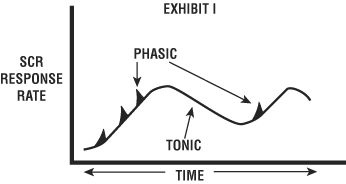 |
c. The mind, through the brain, only exerts as much electrical energy to attend to a stimulus as it needs to in order to satisfy its curiosity, interest or whatever the motivating influence was, before going back to its "journey of rest." (We have concluded that the human mind is either very efficient in this regard or very lazy - take your pick.)
d. However, the human spirit, through discipline, restless curiosity and/or desire, can frequently overcome this natural tendency.
e. Observing a test subject's tonic and phasic patterns to a control video and a series of commercials tends to reveal much about the individual's personality and temperament.
f. The very young tend to have the highest tonic levels, which decline with age (along with everything else, some would say).
g. To obtain the most analytical benefit from SCR measures, it is important to combine each respondent's questionnaire response with his/her SCR responses. This provides a synergy of insight that either type of measure alone cannot offer.
Examples of analytical enhancement from combining SCR measures with questionnaire data
1. Personality and temperament play a key role in determining how an individual will react to various stimuli 13. For example, the level of electrical activity, as measured by microsiemen values (MSV) at rest, prior to stimulus onset, provides a good indication of how likely a target audience subject will react to a given commercial. Exhibit II shows the results of a test based on 40 commercials (in a mix of beer, soft drink, fast-food, food, and several other categories), using a pre/post attitude/persuasion measure.
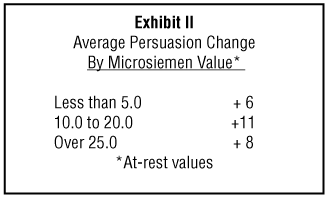 |
Introverts, particularly those with insecure and suspicious temperaments, tend to register very low MSVs and are generally the most difficult to persuade. Extroverts, with mid-range values, seem to be relatively more open to being favorably influenced, while those with very high values appear to be relatively less likely to be influenced than those with mid range values, but more so than those with very low MSVs. 13
2. Commercials with lots of quick cuts generally score poorly on one-exposure recall measures such as day-after recall. We routinely use two exposures, in a pod of four, separated by a control piece. Often, for this type of commercial, tonic response, which we call viewer involvement profile (VIP), shows a continuous declining pattern during the first exposure, but reverses during the second exposure, among those with a positive pre/post persuasion score. An example from a sales-successful snack spot (one that increased sales in a controlled test according to the client), with over 40 cuts in 29 seconds, demonstrates this (Exhibits III A and III B).
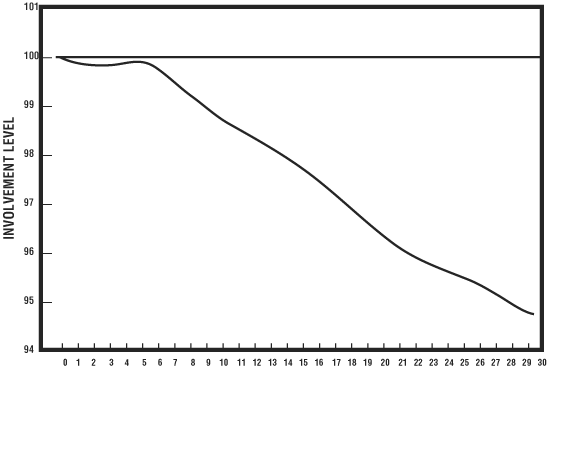 |
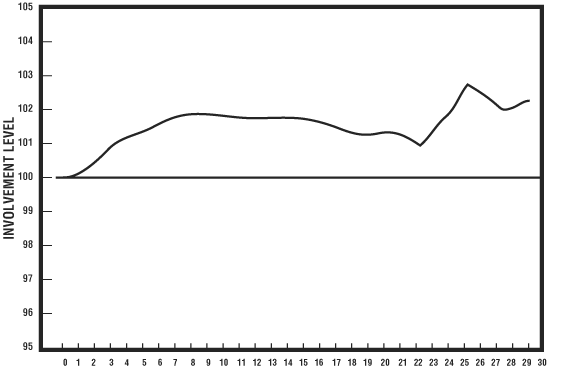 |
We believe that there was cognitive processing overload during the first viewing. In other words, after the first few seconds, the mind is struggling to absorb what it has just seen and doesn't really catch up until the second viewing. (Skin conductance response increases only as the mind is focused on taking in external stimulus information. As it internalizes, SCR decreases, while the mind decides what to do with the stimulus information already received moments before.)
3. By taking 10 SCR measures per second and averaging to one, we obtain a stable value for each second. While magnitude of change from second to second or over several or more seconds is important, direction of change, however small, is more important. By examining the questionnaire ratings responses between SCR gainers and decliners for each second, we can determine the importance of each second to the overall effect and affect of the commercial.
An example of this is a fast-food commercial which featured a two-for-$2 promotion. While the seconds with beauty shots of the sandwiches with a voiceover sales pitch were important, the four seconds of the company's long-time musical jingle were even more important (Exhibit IV).
 |
We hypothesize that the jingle reminded many respondents' unconscious memory of how much they liked this company and the many pleasant moments they had spent eating its popular sandwiches. These accumulated favorable memories gave the conscious mind permission to react favorably to the two-for-$2 offer.
Many creatives intuitively know the power of music, both with and without lyrics, but have never had a means to prove it. SCR measures we have taken of commercials where music was involved have demonstrated that power.
4. Earlier we mentioned that SCR could identify certain personality characteristics such as extraversion/introversion and stability/neuroticism. One example of the use of this occurred when we compared two beer commercials. (The major beer companies all tend to target primarily young males of legal age who drink a certain minimum number of beers per week.) We examined two commercials that had a strikingly different affect on different personality types (Exhibit V).
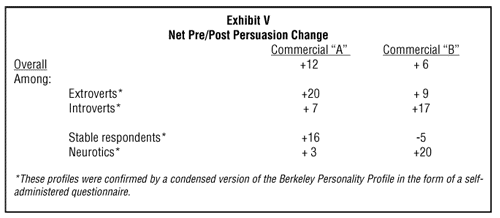 |
There were twice as many extroverts as there were introverts in each sample. Hence, the stronger overall preference change for commercial A. (In the population at large, Myers-Briggs estimates there are two to three times as many extroverts as there are introverts.)
We hypothesize that the more relevant the subject matter of the commercial is to the consumer's interests/needs, generally, the more effective is the commercial. Similarly, the more alike the commercial's characters are to the personality of the viewer, the more favorable the results are likely to be.
In commercial B the principal character was boastful, which was obviously masking an insecure personality; yet the predicaments his pals got him into created some sympathy, and more importantly, empathy, among viewers who were similarly insecure. In commercial A the principal character was outgoing, assertive, and sure of himself, but not in an offensive way.
Being able to identify effective and affective results by personality differences would seem to offer fertile ground for advertisers with high-image brands.
Valence
The most common question researchers ask about SCR is: How do you know if an inclining graph is favorable and a declining graph unfavorable?
The short answer is that we simply look at the questionnaire response for those respondents with an inclining and conversely for those with a declining graph. (See Point 3 above.) A better answer is when it comes to advertising, it is almost always true that the more attention, the better. A more technical answer is that any real negative generally evokes a phasic response that will be sharper, stronger, and shorter than favorable or neutral responses. Ironically, SCR will usually provide a more definitive answer to this question than the often middling responses to survey questions.
Summary
I. It is evident that more and more brain researchers have established beyond question that cognition is a dual function of both conscious and unconscious processing. And that of the two, unconscious processing is usually the more dominant and, in effect, controlling. (For a more in-depth discussion of the levels of unconsciousness, the reader is referred to John Kihlstrom's The Cognitive Unconscious. 14
II. Further, brain researchers have found skin conductance to be a reliable and useful tool to aid their investigations.
III. In view of this, employing a physiological measure such as skin conductance is necessary in order to obtain a more complete understanding of the dynamics that are at work in a television commercial or any time-based visual or auditory stimulus. Our work in combining SCR and questionnaire responses clearly support this contention.
Answer is obvious
What does all this brain research evidence have to say to advertising creators, approvers, and researchers? The answer seems obvious. Advertising research needs to develop techniques that incorporate measures of both conscious and unconscious reaction. The conscious part is easy; the need for measuring the unconscious part has to be brought to the attention (pun intended) of the creators and approvers of advertising.
Reference notes
1 The Strategy of Desire, Ernest Dichter, 1960, p. 61
2 The Anatomy of Reality, Jonas Salk, 1983, p. 93
3 "Perception, Attention, Learning and Memory," American Psychologist, Feb. 1996, p. 141
4 The Emotional Brain, Joseph LeDoux, 1996, Pp. 57, 59, 71
5 The Right Brain and The Unconscious, Rhawn Joseph, 1992, pp. 60, 67, 91
6 "Do Adolescents Attend To Warnings in Cigarette Advertising? An Eye-Tracking Approach," Krugman, Fox, Fletcher, Fischer and Rojas, 1994, Journal of Advertising Research, vol. 34, pp. 39-52
7 "Brain Imaging Detection of Visual Scene Encoding in Long Term Memory for TV Commercials," Rossiter, Silberstein, Harris and Nield, March/April, 2001 Journal of Advertising Research, pp. 13-25
8 "GSR RECONSIDERED: A Behavior Based Approach To Evaluating and Improving the Sales Potency of Advertising," LaBarbera and Tucciarone, Journal of Advertising Research, Sept/Oct, 1995, pp. 33-53
9 "Autonomic Measures of Advertising," Watson and Gatchel, Journal of Advertising Research, June, 1979, pp. 15-26
10 "Electrodermal Measurement: Particularly Effective for Forecasting Message Influence on Sales Appeal," Hopkins and Fletcher, Measuring Psychological Responses to Media Messages, Lawrence Erlbaum Associates, 1994
11 "Activation Research: Psychobiological Approaches in Consumer Research," Kroeber-Riel, Journal of Consumer Research, Vol. 5, March 1979, pp. 240-250
12 Descartes' Error, Antonio Damasio, 1994, pp. 207, 208
13 Emotions, Cognition, and Behavior, Izard, Kagan and Zajonc, 1984, pp. 133, 134
14 "The Cognitive Unconscious," Kihlstrom, Science, Sept. 18, 1987, pp. 1445-1452
